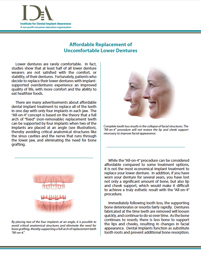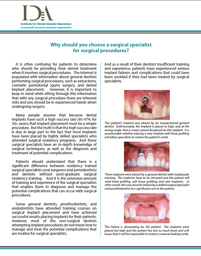- Dental Implants
- Treatment Options
- Implant Procedures
- Success Stories
- Resource Library
- Bone Grafting
- Sinus Grafting
- FAQ
This “state-of-the-art” dental technology makes it possible to restore the mouth as closely as possible to its natural state and eliminate the need to cut down adjacent teeth for bridgework.
Dental implants are substitute tooth roots, used to replace natural tooth roots in areas of the mouth where teeth are missing. Dental implants provide virtually the same function as natural tooth roots, stimulating bone growth, preserving bone, and providing a stable foundation for replacement teeth.
Why Dental Implants?
Dental implant treatment is the only tooth replacement option that provides the following benefits…
- Preserves bone/prevents bone resorption (deterioration)
- No compromise to the health of adjacent teeth
- Highest success rates and best long-term prognosis
And dental implant treatment is also the most cost-effective treatment option long-term!
Frequently Asked Questions
This publication from the Institute for Dental Implant Awareness answers the most frequently asked questions about dental implant treatment.
IDIA Health Letter Frequently Asked Questions
For more information about the benefits of dental implants, we encourage you to visit www.MissingTeeth.org.

This method of tooth replacement can be very esthetic and functional for a period of time. However, a tooth-supported bridge does not replace the bone that previously surrounded the root. Since there is no longer a root to hold the bone in place, the bone deteriorates, or melts away.
There are many advantages to replacing a single missing tooth with an implant-supported crown:
- Looks, feels and functions like a natural tooth
- Much more esthetic long term
- Does not decay
- No need to grind down the adjacent natural teeth
- The bone is preserved, preventing a visible defect
- Easier to clean than a tooth-supported bridge
When more than one tooth is missing, there are three common treatment options: the traditional tooth supported bridge, a removable partial denture and an implant supported bridge. In this situation the benefits of implant-supported teeth are even more obvious.
A removable prosthesis, such as a partial denture, actually accelerates the bone resorption (deterioration) process that occurs naturally when teeth are lost or removed. In addition, the clasps that hold the partial denture in place put significant pressure on the natural teeth they hook onto, loosening them and in many cases, eventually leading to the loss of those teeth. Most patients with partial dentures state that they are uncomfortable and that they rarely wear them.
The advantages of replacing multiple missing teeth with implant-supported bridges include the following:
- Look, feel and function like natural teeth
- Much more comfortable and stable than partial dentures
- Natural biting and chewing capacity is restored
- Virtually stops the bone resorption (deterioration) process
- Integrity of the facial structures is maintained
- Adjacent natural teeth are not cut down into peg shapes for a bridge, or loosened by partials hooked onto the teeth
Replacing all of the Teeth
In the past, people missing all of their teeth had no option but dentures. This prosthesis has numerous disadvantages, such as:
- Dentures are uncomfortable and often painful
- Dentures do not look natural, especially when eating
- As the bone continues to melt away, the dentures become loose, and can fall out when laughing, sneezing, or coughing without the use of adhesives
- People without their teeth and supporting bone visibly age much faster
- Wearing dentures undermines self confidence
- It is difficult to eat certain foods, such as steak, corn on the cob and apples
- People with dentures generally have bad breath
These problems can be solved with implant supported replacement teeth, which are stable (securely fastened to the implants) and maintain the integrity of the facial structures by preserving the bone.
Some of the many advantages of implant-supported replacement teeth include the following:
- They are more comfortable and stable than traditional dentures
- They virtually stop the bone resorption (deterioration) process
- Integrity of the facial structures is maintained
- Appearance is improved
- It is not necessary to cover the roof of the mouth, so food can be tasted
- Relines and repairs are infrequent compared to traditional dentures
- Natural biting and chewing capacity is restored
Surgical Evaluation. Following the initial consultation, you will be referred to Dr. Beaty for a comprehensive surgical evaluation. This will typically be for the purpose of further evaluating the quality and quantity of available bone to determine the number of implants necessary, as well as whether additional procedures may be needed to obtain the desired functional and esthetic result. If you have already lost a significant amount of bone, the doctor will determine whether procedures to add (graft) bone, or create new bone will be necessary to achieve the optimal treatment outcome. Additional diagnostic x-rays or 3D imaging might also be recommended.
Once the surgical evaluation has been completed, a treatment plan will be developed with your general dentist to meet your individual functional and esthetic needs.
Implant Placement Procedure. The implants are placed in the bone using a gentle surgical technique. Following the implant placement procedure, the implants are left undisturbed for a period of several weeks so that the bone can remodel around the implants to form a strong biological bond to them. During this bone-remodeling phase, you will have some type of temporary replacement teeth, so that you never have to be without teeth during treatment.
Abutment Attachment Procedure. Following the appropriate bone-remodeling period, a small connector post called an abutment is attached to each implant. The permanent replacement teeth will eventually be attached to the abutments.
Fabrication of Replacement Teeth. Your dentist will then take impressions of your teeth and the implant abutments; place temporary replacement teeth and select the appropriate shade for your replacement teeth. The laboratory technician will fabricate your replacement teeth and the underlying structures that will be attached to the implants. Then your dentist will check the replacement teeth for proper fit and attach them to the abutment.
Bone Grafting
Many times due to progressive disease, infection or trauma, bone and soft tissue are lost in areas around the teeth. Bone resorption, or deterioration, occurs naturally when teeth are lost or removed unless dental implants are placed to preserve the bone.
Fortunately for those patients who have lost bone, it is possible to augment or replace the bone with grafting techniques and successfully place implants. And any defects in the bone in the front of the mouth can be corrected to create the proper facial contours and tissue support necessary to achieve optimal esthetic results.
If small defects are present in the desired implant location, a bone graft with either real or synthetic bone is used to fill in the defects. Sometimes the bone graft can be accomplished at the same time as implant placement. This type of graft takes the same time to heal as it takes for the bone to remodel after the implants have been placed.
If there is a substantial amount of bone loss, which prevents the placement of dental implants, a block of bone can be removed from the chin or behind the lower back teeth and transplanted to the area in need. These grafts typically require four to six months to heal and form new bone identical to the shape of the transplanted block. Implants can then be placed securely in this bone. It will usually take another three to four months for the bone to remodel around the implants.
Our Resource Library provides information on current issues, including misconceptions created by questionable advertising claims that are often confusing for patients. These articles were provided by the Clinical Advisory Board of the Institute for Dental Implant Awareness, a non-profit consumer education organization.
Marketing Myths about Dental Implants
Common marketing myths that have created misconceptions about dental implants are addressed, such as implant “super” centers, “bargain” implant treatment, and mini dental implants.
Affordable Replacement of Uncomfortable Lower Dentures
The “All-on-4” procedure is being advertised as an affordable option for complete tooth replacement, but there are more affordable treatment options for replacing dentures.
Why should you choose a surgical specialist for surgical procedures?
Although many non-surgical dentists surgically place dental implants, they have not all had extensive training and experience – especially compared to the experience of an ADA recognized surgical specialist.
Some patients have lost to much bone for implants to be placed without first adding bone to the jaw.
Bone from the patients own jaw is often the best for rebuilding the area. Bone grafting is usually done in the office and does not require hospitalization. Once the bone has been reconstructed, the implants can then be placed into proper positions where they can do the most good.

Many patients seek treatment to replace lost back teeth in the upper jaw but do not want a removable denture to replace them.
Many times the hollow sinus is in the way and makes it difficult to place dental implants in this area. Through the use of modern bone grafting techniques, it is possible to add bone to the bottom of the sinus so implants can be placed and a bridge can be made. The implant bridge is fixed in its final position with screws or cement and does not ever have to be removed by the patient. This procedure can usually be done without the use of the patients own bone making recovery much simpler.






